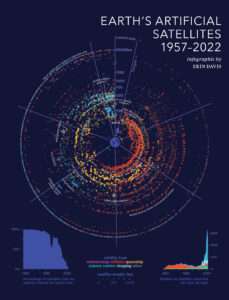
 The Federal Communications Commission (FCC) has transformed significantly since its birth, taking on new powers and responsibilities as technology evolves. But one thing long remained the same: the agency's New Deal–era official seal, virtually unchanged since the FCC was established in 1934. The seal featured bright red characters spelling the commission's name on a field of blue, while a bald eagle flew over telegraph lines in the center, clutching lightning bolts in its claws.
The Federal Communications Commission (FCC) has transformed significantly since its birth, taking on new powers and responsibilities as technology evolves. But one thing long remained the same: the agency's New Deal–era official seal, virtually unchanged since the FCC was established in 1934. The seal featured bright red characters spelling the commission's name on a field of blue, while a bald eagle flew over telegraph lines in the center, clutching lightning bolts in its claws.
In 2020, the FCC announced an internal contest to design a new seal. The winner, submitted by the branding strategy consultant Umasankar Arumugam, included a new element right in the center: Emblazoned atop a shield clutched by an eagle, a tiny satellite hangs in the starry sky.
The change was symbolic, but it reflected something profound. The FCC—born in the age of telegrams, telephone switchboards, and families gathered around living-room radios—was now a regulator at the center of the commercial space renaissance. As the agency observed when it announced the change, the new seal depicts the "communications technologies currently transforming our world." The FCC's history shows that commercial enterprises and market mechanisms are best positioned to drive such innovations. If advocacy groups, industry, or other parties want the space industry to fulfill its potential to "transform our world," they should look to telecommunications law.
A Telegraph-Age Agency in a Space-Age World
In 1934, Congress passed the Communications Act, which created the FCC and directed it to "make available…to all the people of the United States…a rapid, efficient, Nation-wide, and world-wide wire and radio communication service with adequate facilities at reasonable charges."
The initial execution of this mission left much to be desired. For many years, the commission allocated spectrum by having "comparative hearings"—a cumbersome and somewhat subjective process in which competing applicants in a number of industries would spend months or years trying to demonstrate why letting them use a particular frequency in a particular location would better "serve the public interest" than letting a competing applicant use that segment of the spectrum. These "beauty contests," as they came to be known, put the commission in the same impossible position as all other central planners. From their famed vantage point eight floors above Washington, the commissioners were charged with the nearly impossible task of anticipating what the future communications needs and desires of 300 million U.S. consumers might be.
In the 1980s, when cellular telephone service became commercially available, the agency effectively threw up its hands and asked Congress for a new approach, and lawmakers obliged. Instead of conducting comparative hearings, the FCC began to conduct geographic lotteries for spectrum rights. The commission's rules also effectively permitted new licensees to sell those use rights to other operators. The consequences were predictable: Applicants often entered the lotteries with no intention of providing service utilizing the spectrum they acquired, instead "warehousing" it for sale to someone who would. Spectrum did eventually percolate into the hands of operators who could put it to better use than a regulatory body with limited time and resources could have predicted, but not before middlemen were enriched.
That said, two decades earlier, the seeds had been planted for a revolution that would come to transform telecom policy in the U.S. and around the world. Ronald Coase, then an economist at the University of Virginia, wrote an article in The Journal of Law and Economics. Titled simply "The Federal Communications Commission," the paper proposed a way to allocate spectrum more efficiently: by auction.
The FCC, Coase suggested, should hold out a section of the electromagnetic spectrum, divided into chunks of a few megahertz each, and accept bids from interested parties who sought to use it to provide service. Bids would be evaluated almost entirely in terms of dollar value, with less attention paid to the merits of this or that proposed business plan. The primary purpose of the auction paradigm would not be to raise money. The point would be to put skin in the game and gauge the value of the business a prospective operator envisioned. Coase reasoned that an entrepreneur would be unlikely to bid $1 billion for a few megahertz of spectrum unless she were confident her returns would be even greater. And if she came up short, she'd be left holding the bag, a calculation similar in some ways to that of an entrepreneur seeking a loan to start a business.
The article became one of the most influential economics papers of the last century. But for decades, hardly anyone listened to Coase. When he testified to the commission, Commissioner John S. Cross asked, "Are you spoofing us? Is this all a big joke?" Much later, when Washington abounded with proposals to liberalize, marketize, and privatize, officials paid more attention. Thirty-four years after the publication of Coase's article, the Omnibus Budget Reconciliation Act of 1993 authorized the FCC to conduct its first spectrum auction. Since then, more than 100 auctions have been held. They have brought in over $200 billion for the Treasury, and the benefit to the public in the value of service provided has been greater still.
Federal Space and Satellite Regulation Today
As technology evolves, the FCC has applied its authority in new and diverse ways. For example, it interpreted its statutory authority to regulate over-the-air broadcasting as the power to regulate cable, which in the early days was used primarily to deliver broadcast signals to remote areas. Similarly, in the 1980s the FCC used its authority to regulate interstate wireline communications as a basis to structure the information services industry. The commission relied on the fact that the Regional Bell Operating Companies, which in those days held legal monopolies on local telephone service in most of the country, used the same wireline infrastructure to carry online interactive data services as they did to provide voice telephony.
Beginning in 1972, the commission recognized the potential for greater private sector involvement in the nascent satellite industry, and adopted its open skies policy, accepting applications by private companies to operate their own satellite systems for the first time. In doing so, the commission showcased the tremendous ability of deregulation and liberalization to fuel growth and innovation, as new technologies are put to use by operators in a competitive market, for the benefit of the consumer. However, if you're putting nearly anything in space—be it a communications satellite, a weather satellite, even a human being—you're going to communicate with it. (So unless you plan to drop film canisters through the atmosphere on parachutes, as U.S. spy satellites did during the Cold War, you're going to need an antenna.) And so, citing its statutory obligation to maximize the efficient use of spectrum, the commission has extended its jurisdiction to almost every aspect of the new private space industry, just as it did the terrestrial wireless industry, from launch all the way to de-orbit.
Among other things, the agency parcels out orbital altitudes to ensure that constellations of satellites in non-geostationary orbit do not collide or cause interference to each other. Planet's Earth-imaging constellation, for example, is licensed to orbit at different altitudes and inclinations than Capella's. For satellites in geostationary orbit—that is, satellites that orbit the Earth every 24 hours above the equator and appear to hang motionless in the sky—the commission manages orbital slots from east to west. The commission regulates these positions not only to prevent satellites from bumping into one another, but also so consumers fiddling with dish sets on their roofs can more easily receive the right TV signal by aiming at a specific point in the sky.
Because satellites can be likened to flying radio antennas, the commission regulates satellite spectrum bands, power limits, beam pointing, and many other technical bits and bobs meant to keep the airwaves free of destructive interference, even when emissions are occurring hundreds or thousands of kilometers above Earth. The commission also regulates reserve propellant requirements, orbital inclinations, relocation on orbit, reentry and disposal plans, orbital debris, and more. But all of these have one thing in common: Each affects the ability of space and satellite companies to operate without causing harm or interference to other licensees, implicating their legal rights and obligations, and triggering the jurisdiction of the FCC. Today, this body of rules forms the basis of countless applications, oppositions, and other pleadings filed by these operators at the FCC every year, as they request (and contest) the right to operate in space. If a casebook were ever compiled on federal space and satellite regulation, it would be little exaggeration to say the majority of the cases would begin with the boldface header, "Before the Federal Communications Commission."
These space services have transformed human life on Earth in more ways than many truly realize. Orbiting cameras and radars generate renderings of life on the surface at a resolution of mere centimeters per pixel, and they cross over the same part of the planet so frequently that they can be thought of as a live feed with a slow frame rate, helping farmers to optimize crop yields and first responders to fight wildfires. Breathtaking satellite internet constellations proposed by providers such as SpaceX, whose Starlink system has grown from thousands to tens of thousands of spacecraft through successive applications at the FCC, promise to deliver high-speed, low-latency broadband to the entire world, facilitating rural internet access without the need to deploy costly terrestrial infrastructure in remote regions. At the same time, fleets of satellites in geostationary orbit connect with devices aboard oil rigs, cargo ships, and airlines, providing vital connectivity for the long supply chains upon which modern life depends.
And as the space sector evolves, new technologies keep prompting the agency to reimagine its role—and expand its turf. The FCC has published a draft notice of inquiry into in-space servicing, assembly, and manufacturing, a part of the space economy still in its infancy. But while these technologies might be futuristic, the commission's role in the process is the same as ever. It will be interested in hearing how these new technologies implicate (or obviate the need for) the rules it has issued in the past. In scenarios where mission extension vehicles can fly out to various orbital locations to refuel satellites, some commenters might ask whether the commission could reexamine its requirement that satellites carry reserve propellant for de-orbiting. Or, when on-orbit repair of faulty spacecraft becomes more widespread, some commenters might ask whether satellite components such as radiators and power systems need to be so stringently regulated for reliability and at such expense. These are highly fact-dependent inquiries, and it is hard to predict what the answers will be, but the commission recognizes a prudent point: As with the early days of radio, there is little need to impose burdens on space and satellite operators beyond what is necessary to prevent interference and harm to others.
A New Space Age (If You Can Keep It)
The stage now looks set for a return to space in earnest, and the beginning of a new Space Age, though the current iteration has a lot to live up to. In 1965, the Communications Satellite Corporation—the quasi-governmental body responsible for operating satellites before the open skies policy was implemented in 1972—deployed the first constellation of satellites into geostationary orbit, more than 35,000 kilometers (about 21,750 miles) above the equator. The mission's goal was to do something that had never been done before: to reach the entire population of the world with a single broadcast at once and to do it live. In 1967, Our World was broadcast to audiences around the planet, as a voice-over announcer declared, "For the moment we're going to ignore our differences and focus on what we have in common….For we are, in a sense, electric Magellans, on an exploration without precedent."
Then the Beatles took to the stage and, joined by members of the Rolling Stones and other artists in the chorus, delivered their debut performance of "All You Need Is Love." Four hundred million human beings were watching—more than one in 10 members of our species, brought together for a single shared moment. It was the largest live broadcast event in history, and it would remain so until it was surpassed by Apollo 11 two years later.
That heady moment would be the zenith of the first Space Age. Humanity made 139 attempts to reach orbit in 1967, more than any before it, but also more than any to come—until now. In 2021, for the first time since 1967, our planet set a new record for orbital launches, with 144 attempts.
More than 40 percent of these launches bear the flag of the People's Republic of China, whose state-owned companies are rushing to create copycats of innovative U.S. space startups in a bid to close the gap with our commercial space sector. At the same time, the Chinese military continues to develop and even test anti-satellite weapons, generating orbital debris that threatens the peaceful use of space by other operators, attracting strong rebuke from U.S. officials. These dangerous developments underscore the importance of maintaining U.S. leadership in space, and it is important to recognize where that leadership has come from. The U.S. has surged ahead by fostering a regulatory environment conducive to a self-sustaining market for space activities that stands on its own two feet. The vast majority of American launches are conducted by private providers for private customers. We go to space now to connect with one another, entertain one another, and watch out for one another. In other words: We come in peace.
Though some might first think of NASA when contemplating the federal government's role in space, the FCC has great influence over these important extraterrestrial activities—at least in a regulatory sense. The commission has effectively become America's primary space regulator, and those interested in building on this peaceful, private sector–driven, market-oriented vision of federal space and satellite regulation must set their sights on telecommunications law.
The post The FCC: America's Other Space Agency appeared first on Reason.com.







